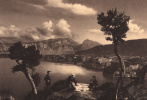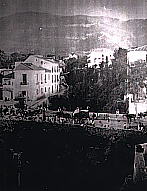|
History of Sorrento
Origins
Eruption of the
Vesuvius in 79 A.D.
Sorrento in 420 A.D.
Sorrento (1133-1656)
Sorrento in 1799
Reign of Ferdinand II
|
Sorrento
Beaches Marquety
Personages Typical
Dishes Typical Products
Place to Visit
ORIGINS
About the origin
of Sorrento the historian Diodoro Siculo, relating to a
legend, asserted
that the town was founded by Liparos, son of Ausone, who
was the king of the Ausoni and son of Ulysses and of the witch Circe.
According to this legend, the origin of the town dates back to
an ancient Italic
population, that of the Ausoni, which accounted for one of the most
ancient ethnic groups.
However
the town in pre-Roman age was subjected to a certain
influence on the part of the Greek culture, whose traces
can be easily found in its urbanistic settlement, the remains of the
Parsano Gate, Marina Grande
Gate, let alone the presence at the headland of the peninsula
called Punta Campanella, of the
Athenaion. The big sanctuary, where the worshipping
of Athens was celebrated, according to the legend, it was founded by
Ulysses and in a first moment consecrated to the worship of
the Sirens. All these elements could lead us to think of a
Greek presence in the
period between 474 and 420 b.C., when Sorrento was conquered
by the Samniti.
Following this Sorrento entered under the Roman's sphere of influence,
against which it rebelled in the course of the social war when after
joining the 'nucerina alliance' it was reconquered, together with Stabia,
by Papius Multius in 90 b.C. and then the following year it was reduced
once again to a state of submission by Silla. After the peace Silla
sent a colony of veterans there.
Eruption of the
Vesuvius of 24th August 79 A.D.
On
24th August 79A.D. the town was seriously damaged by the earthquake,
caused by the eruption of the Vesuvius which destroyed the
towns surrounding the area such as Pompei, Herculaneum and Stabia.
Sorrento as a holiday resort
During
the first half of the Imperial age it became a very popular seaside
resort among the wealthy patricians, who considered the entire
Gulf of Naples, from the
Flegreian Plains to Sorrento, an ideal place to spend the summer
months and the otium periods.
Therefore several Villae
Maritimae were
edificated in this area: magnificent lodgings, each with a landing
place from the sea, spacious
private residences, sometimes also farms where oil
and wine were produced with the crops belonging to the dominus.
Horace
The
fame of Sorrento is also commemorated by Horace and Stazius, who in
his work Silvae praised the
beautiful sights and in particular the Villa of his friend Pollio
Felice.
Sorrento
in 420 A.D.
Sorrento
had an archiepiscopal site around 420 A.D., and after the fall of the Roman
Empire it was subjected to Byzantium. It was in vain besieged by the
Longobard. It became a free Dukedom and had to defend itself from
raids by the Saracens; it
struggled against Amalfi, one of the powerful Maritime
Republics, to claim its independance.
Sorrento
from 1133 to 1656
In
1133 it was conquered by Ruggero the Norman and from that moment
its fate was tied
up to that of the King of Naples. On the 13th June 1558 it was
plundered by the pirates, who had been assisted in this by a slave,
who by
the legend, betrayed his fellow citizens and opened the city gates to
the robbers. This episode
persuaded the Sorrentines to fortify the walls
sorrounding the
town and this work was completed in 1567. One of the most
critical times for Sorrento took place in 1648, when a riot broke out
against the Spaniards, headed by Giovanni Grillo. With the
support of the inhabitants of Piano and Massa Lubrense, he tried to
seize the government of
the town where the nobles were faithful to the Spanish power. The big plague
epidemic of 1656, shocked the population further on. But notwithstanding
these series of negative events, Sorrento continued to be an
outstanding centre
among the province's towns.
Sorrento in 1799
In 1799 it joined the Parthenopean Republic and was a theatre
of fights between the
republicans and Bourbons. Back to the Kingdom of the two Sicilies,
under the Bourbon' s rule, it underwent remarkable changes during
the XIXth century
both from an urbanistic and a political point of view: some of
the coastal boroughs were ruled by the counsel of the civic nobility,
while others became
self-governing. In the economic and social field an
increase was registered in agriculture, tourism and trade.
The
Kingdom of Ferdinand II
Under
the rule of Ferdinand II the road leading from Castelammare to
Sorrento was opened. In 1861 it was officially incorporated to
the Kingdom of Italy, by means of a plebiscite, which established the
annexion of the Kingdom of
the two Sicilies to the Kingdom of Sardinia. Already in XVIIIth
century Sorrento was rediscovered as a pleasant holiday resort when it
became the
destination of a refined and intellectual tourism. Among its illustrious
guests we recall above all Lord Byron, John Keats, Walter Scott
and Goethe. Finally it must not be forgotten that Sorrento was
the country home of
Torquato Tasso (1544-1595), author of the Gerusalemme Liberata and
regarded as one of the greatest poets of the XVIth century.
|

Piazza
Tasso ( 900)

View
of Sorrento (900)

View of Marina Piccola (1800)

View of Sorrento ( 900)

Piazza Tasso once...
|
